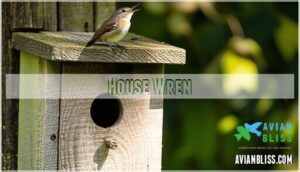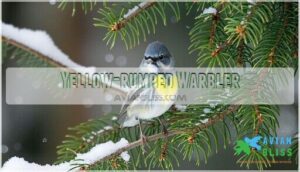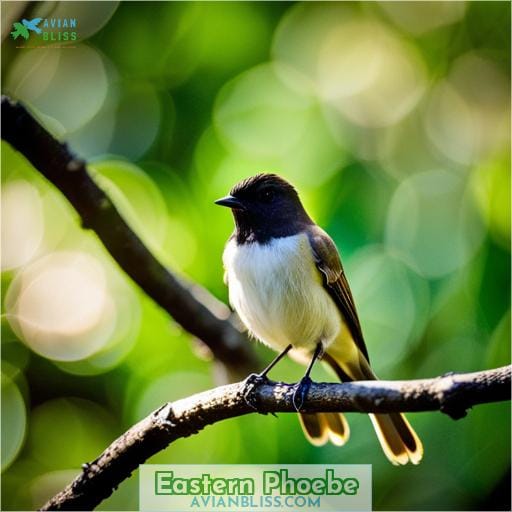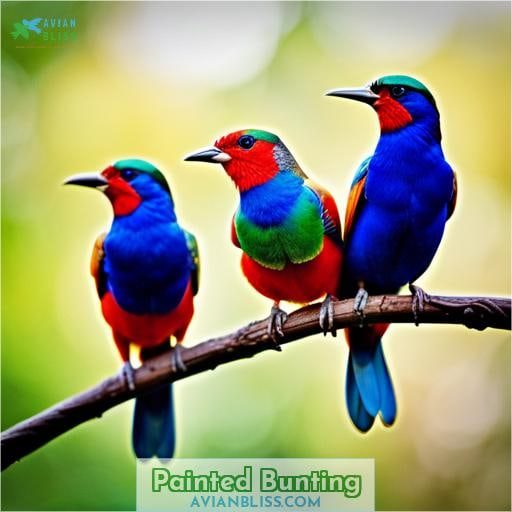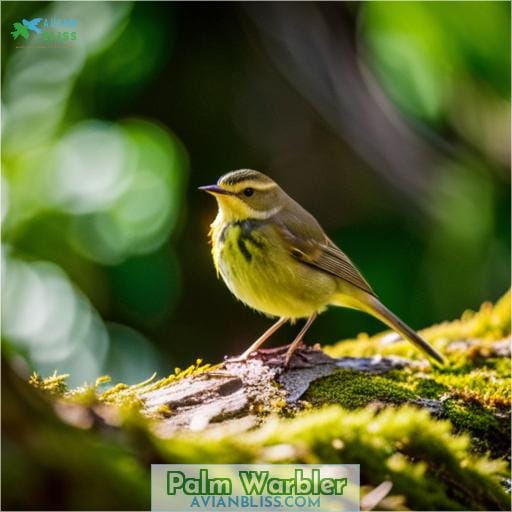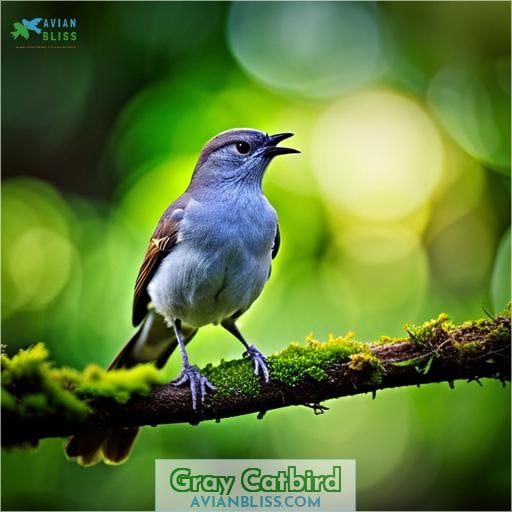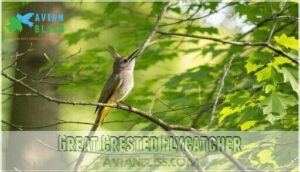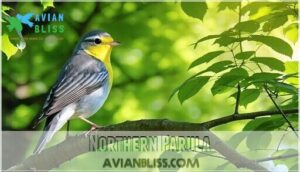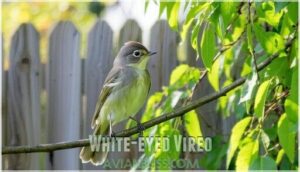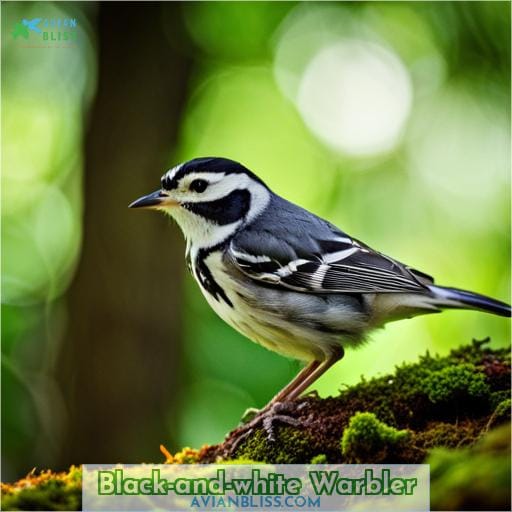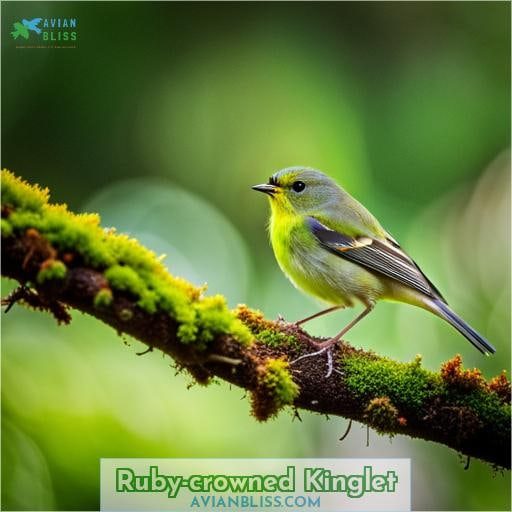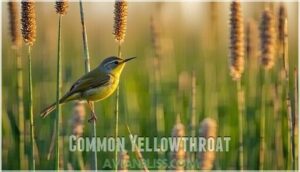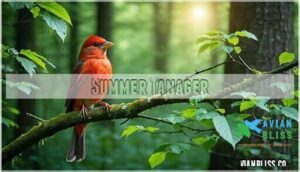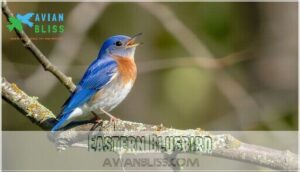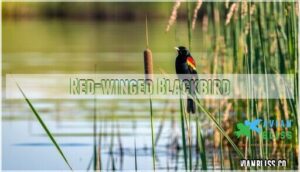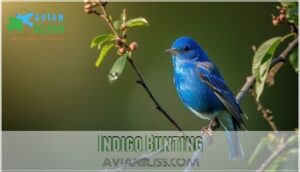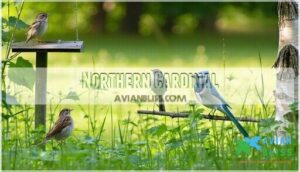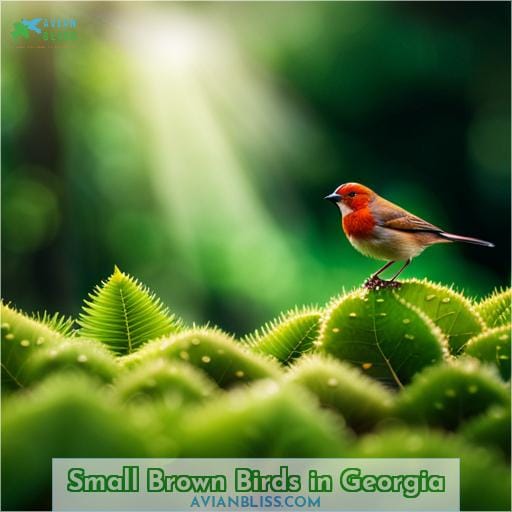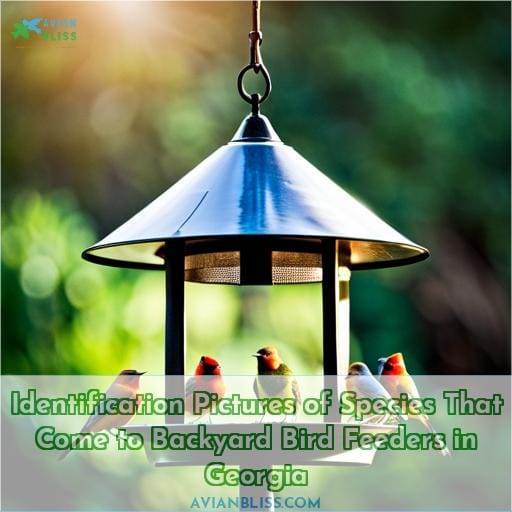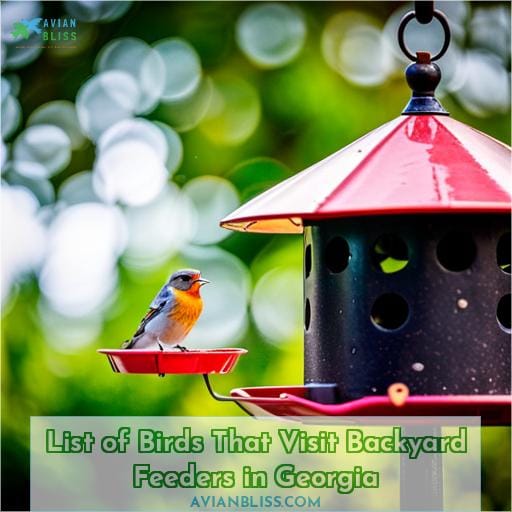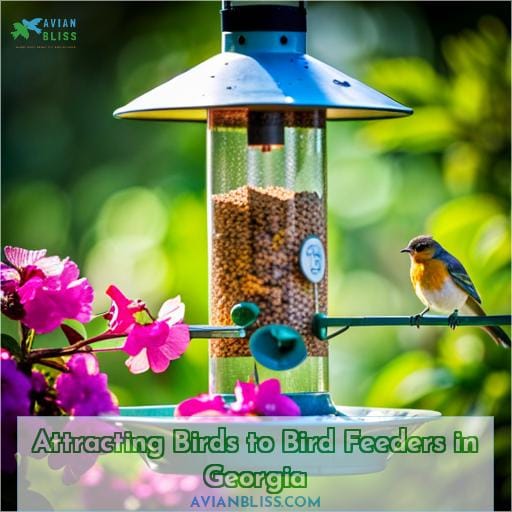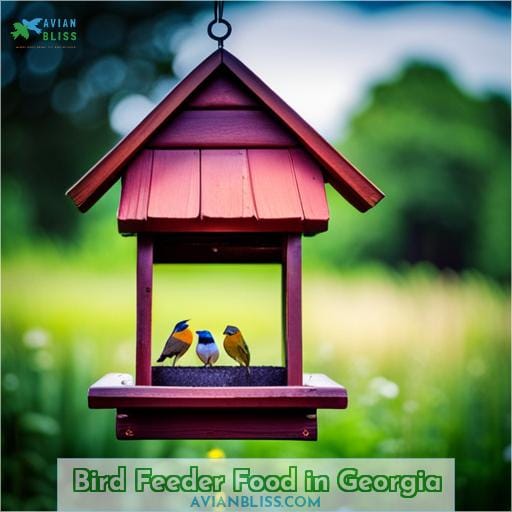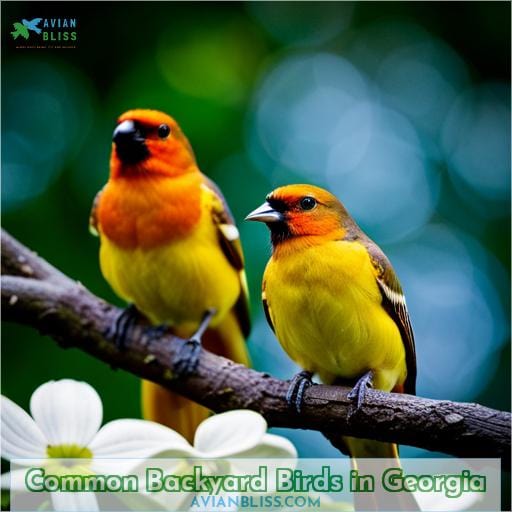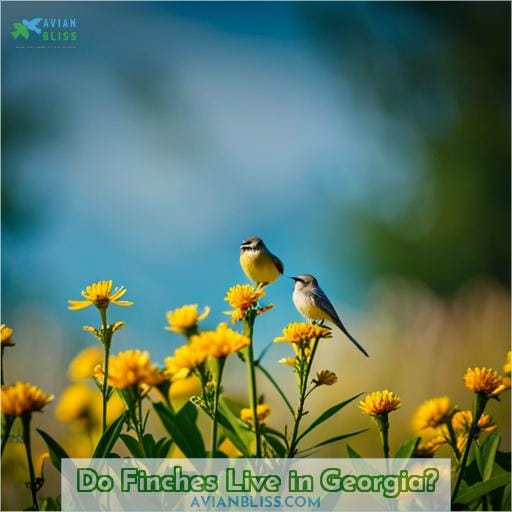This site is supported by our readers. We may earn a commission, at no cost to you, if you purchase through links.
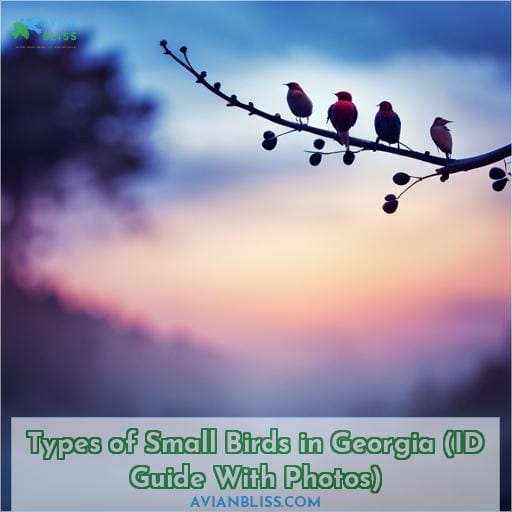
Though Georgia boasts a marvelous array of bird species, it’s the petite beauties who steal your heart.
Their tiny forms belie the incredible journeys that bring them here each year. Nestled amongst fragrant pines, they find sanctuary in your lovingly tended yard. You delight in documenting their songs and colors, adding each sighting to your growing life list.
From the ruby jewels of hummingbirds to the lemon hues of warblers, you’re enchanted by the diversity.
Let your soul take flight alongside these small birds in Georgia. Joy awaits you with each new encounter.
The melody of birdsong stirs your spirit, reminding you of simpler times. You yearn to welcome these winged creatures back to the haven you’ve created. Scouring the trees, you hope for a glimpse of familiar plumes. Though you appreciate all birds, it’s the small birds in Georgia that evoke tenderness.
Watching them flit and forage renews your sense of childlike wonder. You meticulously chronicle each sighting, feeling immense gratitude for their return.
As you lovingly refill your feeders, you envision the Painted Buntings and Blue-gray Gnatcatchers feasting. This season, may your eyes be opened to avian treasures both familiar and new. Let these tiny heralds of spring warm your heart.
Table Of Contents
- Key Takeaways
- Small Birds in Georgia
- Carolina Wren
- Ruby-throated Hummingbird
- House Wren
- Yellow-rumped Warbler
- Eastern Phoebe
- Painted Bunting
- Blue-gray Gnatcatcher
- Palm Warbler
- Gray Catbird
- Tufted Titmouse
- Great Crested Flycatcher
- Northern Parula
- Tree Swallow
- Barn Swallow
- White-eyed Vireo
- Black-and-white Warbler
- Yellow-throated Warbler
- Cerulean Warbler
- Ruby-crowned Kinglet
- Downy Woodpecker
- Eastern Towhee
- Carolina Chickadee
- Common Yellowthroat
- Summer Tanager
- Eastern Bluebird
- Common Starling
- House Finch
- Red-winged Blackbird
- Indigo Bunting
- Northern Cardinal
- Small Brown Birds in Georgia
- Types of Birds That Visit Backyard Feeders in Georgia
- Identification Pictures of Species That Come to Backyard Bird Feeders in Georgia
- List of Birds That Visit Backyard Feeders in Georgia
- Bird Feeder Types in Georgia
- Attracting Birds to Bird Feeders in Georgia
- Bird Feeder Food in Georgia
- Common Backyard Birds in Georgia
- What Bird is Georgia Known For?
- Do Finches Live in Georgia?
- What Kind of Sparrows Are in Georgia?
- Bird Watching Tips
- Frequently Asked Questions (FAQs)
- When is the best time of year to see migratory songbirds in Georgia?
- What is the rarest small bird species that can be found in Georgia?
- What small bird species are expanding their range into Georgia?
- What small bird species have declined the most in Georgia in recent years?
- What are some tips for attracting more small birds to backyard feeders in Georgia?
- Conclusion
Key Takeaways
- Georgia’s backyard hosts a marvelous array of bird species.
- Native trees and shrubs attract Carolina wrens and house wrens.
- Small brown sparrows and finches fill feeders in Georgia.
- Attract finches with nyjer seed, provide cover, use proper feeders.
Small Birds in Georgia
You’re likely to see little Carolina Wrens with their rusty brown backs and House Finches with gray-brown plumage visiting your backyard feeder in Georgia.
From the boisterous Carolina Wren’s ringing tea-kettle, tea-kettle, tea-kettle song to the House Finch’s fast, lively warble, Georgia’s yards and gardens host charming resident birds.
Watch for sociable American Goldfinches with their bright yellow plumage mixing with drab House Sparrows as they flock to thistle feeders.
Plump Mourning Doves may gather below, foraging seeds dropped to the ground.
Take time to appreciate winter visitors too – their migrations and identification enrich backyard birding.
With attentive eyes and ears, Georgia’s feeders promise rewarding glimpses into avian life.
Carolina Wren
From the Ruby-throated Hummingbird‘s iridescent feathers to the Palm Warbler’s distinct yellow throat, Georgia’s small birds display colorful plumages and markings. Yet the Carolina Wren stands out with its bold rufous plumage and striking white eyebrow.
You can attract these boisterous songsters to your yard by providing dense shrubbery for nesting.
Monitor the wren population by learning their repertoire of loud, variable songs. Plant native trees and shrubs like dogwoods and hollies to provide natural food sources. With a little care, you’ll have Carolina Wrens chipping and singing as they hunt for insects and spiders across your landscape.
Observing these active little birds will bring you joy.
Ruby-throated Hummingbird
Even as our state’s smallest bird, the ruby-throated hummingbird‘s miraculous migratory journey and aerobatic flight still astonish. The males arrive first in spring to claim breeding territories. Watch for them investigating your nectar feeders.
Provide fresh sugar water and flowering plants to help sustain their migration. By summer, females appear to start nesting. They build tiny, well-camouflaged nests high in trees using spider silk and lichens.
Keep cats indoors and limit pesticide use to do your part. In the fall, the ruby-throats must again traverse the Gulf of Mexico, flying 500 miles nonstop over open water, an amazing feat for a bird weighing mere grams.
With a bit of care, we can ensure these aerial acrobats keep dazzling us here in Georgia for generations.
House Wren
The House Wren is a tiny songbird with brown plumage and a long tail, wintering over in Georgia where it builds nests in boxes. As you walk Georgia’s trails, listen for the House Wren’s rushing jumble of notes and trills echoing through the woods.
Searching tree hollows and nest boxes, you’ll discover its loosely woven twig nests lined with grasses and feathers. Though small, the House Wren vigorously defends its nesting territory with persistent song.
Returning each fall, it stays through winter alongside titmice, chickadees, and kinglets before migrating north again come spring. Foraging in shrubs and on the ground, it eats insects like beetles, grasshoppers, and spiders.
Differentiate it from the smaller Ruby-crowned Kinglet by its long tail and brown back; its song distinguishes it from the Eastern Phoebe’s raspy fee-bee call.
Yellow-rumped Warbler
The House Wren is a tiny brown bird that winters in Georgia, but comes spring, it migrates north.
In contrast, the Yellow-rumped Warbler, also known as the Myrtle Warbler, arrives in Georgia each fall to spend the winter. You’ll recognize this striking bird by its blue-gray upperparts, bright yellow rump patch, and bold black and white stripes on its face and sides.
Here are some key facts about the Yellow-rumped Warbler:
- Breeds in northern forests and migrates south for winter
- Feeds on insects like beetles, flies, and wasps
- Flocks together while foraging in trees
- Population stable, not a species of conservation concern
- Has the ability to partly digest the wax coating on bayberries
The Yellow-rumped Warbler brightens up the winter birdscape in Georgia. Watch for these active insect-eaters with their flashy yellow rumps flitting through the trees. With a little practice, you’ll be able to identify them by their distinctive appearance and behaviors.
Eastern Phoebe
Cause it hunts insects in flight, you’d be amazed watching the Eastern Phoebe swoop across your yard this winter. With its drab gray-brown upperparts and white throat, this slim insectivorous songbird is a common winter visitor.
Migrating down from farther north, it perches low and sallies out for flying insects. You’ll often spot it near water, where bugs abound. Hunting from branches and catching prey midair, its aerial feats never cease to impress.
Like many migratory species, habitat loss impacts its numbers. So plant native vegetation and reduce pesticide use.
Come winter, enjoy its presence in your yard, benefiting from its appetite for pests. Without this bird, bugs would be more bothersome. So take a moment to appreciate this little hunter’s role in nature’s web.
Painted Bunting
Y’all’d love to spot the colorful plumage of Painted Buntings breeding in southeast Georgia. Their bright coloring marks the males, with beautiful hues of blue, green, yellow, and red. You can identify their songs too – sweet, chatter-like trills to attract mates and defend nesting areas.
Come fall, they migrate in flocks to wintering grounds in Florida, Cuba, and further south. In spring, the males return first, competing with Indigo and other Buntings for territory. Finding a flash of these colors amidst the foliage feels special. Their populations remain secure, but loss of habitat is an ongoing threat.
Spotting a Painted Bunting remains an exciting experience for any Georgia birder.
Blue-gray Gnatcatcher
Y’catch the blue-gray gnatcatcher flittin’ ’bout the trees in winter with its white eyering and partial migratory habits. A real treat seein’ this tiny bird hoppin’ from branch to branch, tail bobbin’, singin’ its sharp twitterin’ song.
Most head down south come fall but some stick around Georgia’s pines n’ hardwoods year-round. They build their tidy cup nests high up using plant down, moss n’ spiderwebs, layin’ 3-4 eggs. Insectivores, they snatch bugs and spiders midair with their long tails streamin’ behind.
Might see ’em mobbin’ bigger birds, protectin’ their nests from jays n’ mockingbirds.
Come spring, enjoy watchin’ the male’s swoopin’ display flight, chasin’ after that gal of his. Keep ears peeled for their zee zee zreeeep call next time wanderin’ the woods. That flash of blue-gray and constant motion lets ya know the gnatcatchers are out huntin’ up high.
Palm Warbler
The Blue-gray Gnatcatcher’s blue-gray upperparts contrast with the Palm Warbler’s dull olive-brown upperparts. You’ll often spot this little warbler foraging on the ground, rapidly wagging its tail up and down.
On its wintering grounds in Georgia, it frequents weedy fields and scrubby woods. Look for its yellow breast and undertail coverts, along with the rusty cap on its otherwise olive-green head. This insectivore breeds far to the north in the boreal forests of Canada, feeding on insects like midges, flies, and beetles.
In fall, Palm Warblers migrate in flocks to the southern United States and Mexico. Here in Georgia, this backyard bird feasts on weed seeds at feeders. You may notice its habit of clinging to vertical surfaces like tree trunks.
With a watchful eye, you’ll discover five fascinating traits of the Palm Warbler.
Gray Catbird
You’ll overhear that raspy, catlike mew of a wintering Gray Catbird as it skulks in some tangled vines! This secretive songbird adds its harsh call to Georgia’s wintertime thickets. Though shy, Gray Catbirds enjoy backyard habitats with dense cover. They eat wild fruits and insects gleaned from low perches.
Concealing its nest takes priority for this wary species. Similar species like Northern Mockingbirds and Brown Thrashers share the catbird’s habitat. However, the Gray Catbird’s smaller size and distinctive mew separate it from these lookalikes.
With patience, you may glimpse this shadowy winter denizen that Georgia hosts each year. Its habits remain mysterious, but you feel rewarded when discovering yet another small bird thriving in the state’s diverse ecosystems.
Tufted Titmouse
You all see that big ol’ Titmouse flitting around the feeder with its fancy feathered cap? That’s the Tufted Titmouse, one of Georgia’s charming little birds.
Nests in tree cavities or old woodpecker holes.
Loud and easily recognizable chick-a-dee-dee call.
Often caches seeds and insects in bark crevices.
Prefers pine woods and mixed forests.
Gray upperparts and white face with pointed black crest.
Fond of sunflower seeds, suet, and peanuts, the Titmouse brings its perky presence to backyards across the state.
A cute lil’ acquaintance for any birder in Georgia!
Great Crested Flycatcher
You’ll want to keep an eye out for the Great Crested Flycatcher as it passes through Georgia in spring migration. Look for this long, slender flycatcher with its reddish-brown wings and lemon-yellow belly perched high, waiting to hawk insects.
The male sports a dashing gray head with a punk rock crest. Listen for its raucous wheep call as it establishes nesting sites in tree cavities left by woodpeckers.
Though insectivorous, it occasionally supplements its diet by raiding nests of smaller birds like blue jays or mourning doves. Help conserve habitat for migrating and breeding flycatchers by planting native trees and reducing pesticide use.
With a little practice, you’ll have no trouble identifying the Great Crested by its size, crest, call, foraging behavior, and preference for high perches.
Keep your eyes peeled because this bird won’t stick around for long before continuing its journey north.
Northern Parula
Well folks, with your keen eye, you’ll be able to spy the Northern Parula’s colorful plumage as it flits through the canopy while passing through our great state. Though tiny, this migratory wood warbler stands out with its brilliant yellow throat against bluish wings.
Noteworthy subspecies variations to observe.
Favorite nesting sites tucked in Spanish moss.
Distinct warbling song filling spring mornings.
Reintroducing such jewels of nature evokes an intimacy with Georgia’s habitats.
As seasons shift, your sightings inform migration economics, population changes, and climate effects for conservation planning.
Like the red-winged blackbird, small birds, sparrows, finches, and house finches need your help through dedicated birdwatching.
Tree Swallow
Gleaming blue feathers will flash overhead as you spot a Tree Swallow swooping low to snatch insects on the wing. As spring arrives, watch for these aerial acrobats hunting insects above fields and ponds.
Males sport iridescent blue-green upperparts that shine in the sunlight. Females and juveniles show more muted plumage of greenish-brown above and white below.
In summer, Tree Swallows nest in cavities like old woodpecker holes. Come autumn, they gather by the thousands in marshes before migrating south to wintering grounds. With luck, you’ll glimpse a dash of dazzling blue as a Tree Swallow zips past on its endless search for flying insects.
Barn Swallow
With your eyes peeled, you’ll spy those rusty-orange bellies of Barn Swallows darting overhead as they feast on insects. These aerobatic aerialists put on quite an airshow, swooping and diving to snatch flying bugs.
Sadly, habitat loss threatens their numbers, so provide nest boxes. Their diet consists mainly of flies, beetles, dragonflies, bees, and wasps. Help track populations through breeding surveys. Work with conservation groups promoting sustainable agriculture and preserving wetlands, fields, and waterways–vital Barn Swallow habitat.
Appreciate their insect control and admire their graceful flight, then bid farewell when they migrate south for winter.
White-eyed Vireo
You’ll marvel at glimpsing the white-eyed vireo‘s grayish-brown and white plumage in your Georgia backyard as this feisty year-round resident aggressively chases off intruders. These vireos have a piercing pit-chee song and a raspy, scolding call they use to defend their nesting territory.
They forage for insects, spiders, and fruit in the shrubby understory, often flicking their tails.
The white-eyed vireo is one of our most common breeding birds in Georgia. They build compact, cup-shaped nests low in bushes. Though not migratory, they do wander southward in winter. Keep an eye out for the white rings around their eyes as they scold other birds from the brush.
Black-and-white Warbler
You’d be astonished at that Black-and-white Warbler struttin’ its black upperparts with white stripes through the backyard.
This active insect-eater spends winters here in Georgia, migrating up to breed in northern forests come spring.
Watch it creeping along tree trunks probing for bugs, flashing those neat black and white feathers.
The male sports a bit more white, but both sexes show those striking stripes.
They build neat cup nests in the north, often on the ground among roots.
Though tiny, these warblers are feisty, chasing off other birds when defending territories.
Keep an eye out when they pass through in April and October.
Their constant tail-wagging gives them away as they forage from magnolias to pines.
With so many species visiting our yards, these striking yet subtle beauties stand out.
Yellow-throated Warbler
The black-and-white warbler decorates the branches with its inky stripes, while the yellow-throated warbler enlivens the leaves with its sunshine colors. You’ll often glimpse this striking warbler peeking through the thickets of Georgia’s woodlands where it nests each spring.
These birds winter in the tropics, then return to claim their nesting sites amid the oaks and pines of your state. Cock your ear for the yellow-throated warbler’s buzzy, ringing song as it flits through the branches.
Appreciate its sunny face against the verdant leaves, with that sharp black mask across its eyes.
This warbler boldly defends its nest from intrusions. Savor each encounter with the yellow-throated warbler, a true harbinger of spring in Georgia’s forests and yards.
Cerulean Warbler
Next y’all catch a glimpse of that endangered Cerulean Warbler with its bright blue back and white belly before it continues migrating through our great state.
This charming bird faces challenges due to habitat loss, leading to a concerning population decline.
Breeding biology-wise, these warblers tend to lay their eggs in deciduous forests, high up in the canopy. Unfortunately, their nesting sites are vulnerable to competition from European Starlings.
Despite these obstacles, witnessing the Cerulean Warbler’s vivid blue plumage against the backdrop of Georgia’s lush woodlands is a true privilege.
As you enjoy the beauty of this fleeting moment, remember that your birdwatching passion contributes to the broader effort of preserving the delicate balance of our avian friends’ lives.
Ruby-crowned Kinglet
Explore Georgia’s vibrant woodlands, where the elusive Ruby-crowned Kinglet awaits your keen observation. In this intimate realm, you’ll witness a tiny gem adorned with a hidden ruby crown, elevating your birdwatching journey.
As you venture deeper, you’ll uncover their behavior secrets. Quick and nimble, they tirelessly forage for insects among leaves and branches. These charming creatures exhibit a penchant for coniferous havens, favoring the shelter of evergreen canopies.
Throughout the year, their seasonal movements grace Georgia’s landscapes, with migration leading them southward. Listen closely to their melodic chatter, a mix of high-pitched notes and trills, adding a soundtrack to your woodland exploration.
Despite their elusive nature, these exquisite birds contribute to Georgia’s natural symphony. Their population trends serve as a testament to the delicate balance of this ecosystem.
Downy Woodpecker
As you observe the lively avian community around, the delightful Downy Woodpecker catches your eye. Recognizable by its black-and-white plumage, it sports a small touch of red on its head’s back. This charming woodpecker is a familiar presence in Georgia and offers a unique experience.
Watching it forage on tree trunks and branches, you’ll notice its distinctive behavior – tapping rhythmically in search of insects and larvae. These resourceful birds display an adaptable feeding preference, switching between insects and seeds, which they deftly extract using their specially evolved bill.
As for nesting, Downy Woodpeckers carve cozy homes in tree cavities, demonstrating their harmonious bond with nature. When it comes to vocalizations, their rhythmic drumming and high-pitched calls resonate through the woods, adding to the symphony of Georgia’s small bird community.
Eastern Towhee
Transitioning from the charm of the Downy Woodpecker, the Eastern Towhee graces the scene with its contrasting palette – a striking mix of black upperparts, rufous back, and white underparts – as it boldly asserts its presence in the wooded landscapes.
You’ll marvel at the following aspects of the Eastern Towhee:
Behavioral Diversity: These sparrows are known for their vigorous scratching, revealing hidden insects and seeds in the leaf litter.
Breeding Habits: During spring, the males sing their Drink Your Tea song, an integral part of courtship, while females build nests in dense undergrowth.
Vocal Variance: Their calls are a medley of whistles, trills, and even mewing sounds, adding a unique acoustic dimension to the surroundings.
Migratory Wonders: Witness their migratory journey as they move to the southeastern United States during the colder months, making them true seasonal performers.
Conservation efforts continue to focus on maintaining their woodland habitats, ensuring the enchanting melodies of the Eastern Towhee grace Georgia’s landscapes for generations to come.
Carolina Chickadee
Roaming through the lush landscapes, you’d easily spot the Carolina Chickadee with its charming black cap, distinctive white cheeks, and those gray backs that seem to dance among the leaves.
This small bird is a true resident of Georgia’s woodlands and gardens, known not just for its appearance but also its lively vocalizations. Listen for their cheerful chick-a-dee-dee-dee call that resonates through the trees, a signature sound of the South.
As the seasons change, so do their habits. Come spring, you’ll find them excavating cozy nests in tree cavities, diligently raising their brood. They’re quite the gourmands too, with a preference for insects, seeds, and berries.
And when winter’s chill sets in, these resourceful birds huddle together and employ an energy-saving strategy, lowering their body temperature during cold nights to conserve energy.
In the delicate world of small birds, the Carolina Chickadee stands as a symbol of resilience and harmony with the Georgia landscape.
Common Yellowthroat
Picture yourself in the lush landscapes of Georgia, where a vibrant array of feathered inhabitants grace your presence. Among them, the Common Yellowthroat stands out like a hidden treasure, with its bright yellow throat and chest adorned like a sunlit jewel against the backdrop of nature’s canvas.
As you venture into their world, the intricate tapestry of the Common Yellowthroat’s life unfolds. Conservation efforts weave into their story, as these resilient birds face habitat challenges. Their vocalization patterns resonate through the reeds, a melodic testament to their presence.
Witness their breeding behavior, a delicate ballet of courtship and nest-building. Imagine tracing their migration routes, a journey spanning continents. And in the quiet hush of observation, you grasp their feeding preferences, the balance of insects and seeds that sustain them.
Through these intimate glimpses, the Common Yellowthroat invites you to share in its existence, a reminder of the beauty of freedom within the wild tapestry of Georgia’s avian realm.
Summer Tanager
As you journey through the fascinating realm of Georgia’s small birds, each species unveils its unique story. Having delved into the enigmatic world of the Common Yellowthroat, let’s now turn our attention to the vibrant presence of the Summer Tanager.
Migratory Marvel: The Summer Tanager, a migratory wonder, graces Georgia with its fiery presence during the warm months. Its vivid red plumage contrasts with the lush greenery.
Nesting Whispers: Nesting studies reveal the tanager’s secluded yet meticulously built nests, tucked away in the tree canopy. It tirelessly tends to its brood, a testament to its dedication as a parent.
Palette of Diversity: The tanager’s vibrant plumage exhibits intriguing regional variations, showcasing the intricate dance between genetics and environment.
Seasonal Appetite: During the breeding season, this beauty’s diet shifts to insects and fruits, aligning with its growing family’s nutritional needs.
As you walk the path of understanding these charming creatures, you’ll witness their resilience and fluctuating numbers, a reminder of the delicate balance they hold in Georgia’s ecosystem.
Eastern Bluebird
You’d find eastern bluebirds singing sweetly in Georgia’s oak savannas, their sky-blue feathers sparkling like sapphires against the rusty orange of their breasts. The male’s brilliant azure plumage and cheerful song brighten even the dreariest winter day.
In spring, they choose nest sites in old woodpecker holes or nest boxes. The female builds the grass-lined nest and incubates the pale blue eggs while her mate brings her food. Both parents feed the nestlings insects like grasshoppers, crickets, and beetles.
Courting males offer females grubs, then flutter up to perch beside her with wings quivering.
Prominent in folklore and popular culture, the eastern bluebird symbolizes joy and the renewal of spring.
Common Starling
You’ve seen the raven-hued invader strolling the ground in flocks, an Old World interloper amidst our avian kin. The Common Starling’s snowy plumage glints as they gather in winter, their oily feathers providing insulation.
Forming large flocks, they descend on yards aggressively, driving off smaller birds. Yet there is beauty in their raspy songs and aerial murmurations, wisdom in their familial bonds. Though non-native, these complex creatures reveal our connectivity. Cherish their mystery, but limit feeding to prevent overpopulation.
House Finch
Y’oughta keep those silly House Finches away from your yard, unless you don’t mind them spreading their disease and driving away the classier local birds like that stylish Common Starling.
Those darned House Finches seem bright and cheerful with their red plumage, but they’re just troublemakers. They nest anywhere, begging for handouts from humans. Their irresponsible habits spread disease to the more refined birds.
Sure, their funny antics at feeders and bright colors entertain folks, but enabling their bad feeding techniques and nesting spots hurts proper local species like Starlings.
In closing, think twice before welcoming messy House Finches that displace better backyard birds.
Red-winged Blackbird
You’re always impressed by the striking red and yellow shoulder patches when a male red-winged blackbird alights on a cattail near the marsh.
The male protects his breeding territory with aggressive displays and calls.
Females are streaky brown and prefer to nest in marshes.
They often forage in fields, sometimes mixed in with cowbirds.
In winter, they form huge flocks numbering in the thousands.
West Nile virus has impacted populations in some regions.
Throughout the year, the sights and sounds of redwings stand out. Watching territorial males flash their epaulets as they sing is a sure sign spring has arrived in Georgia’s wetlands. Females busily tend nests while males vigilantly defend their turf. Come winter, the rattling calls of massing redwings provide an unmistakable chorus.
Their beauty and behaviors make red-winged blackbirds a backyard favorite.
Indigo Bunting
You can watch the sleek blue males sing sweetly from high perches before they migrate south for winter. As a music enthusiast in Georgia, you await the buntings’ return each April when the males flash their brilliant indigo plumage.
They prefer brushy habitat edges near open areas, where you may glimpse them briefly as they flit between low perches. During summer breeding, they utilize old fields overgrown with seed-bearing plants that provide food sources for their nesting sites.
By late September, they’ve headed to Mexico and Central America for the winter. Come spring, listen for their high-pitched, sharp song announcing their arrival back in Georgia.
Northern Cardinal
The brilliant red Northern Cardinal is a familiar sight in Georgia, bringing color to gardens and woodland edges year-round. You’ll undoubtedly recognize this bird by its crested head, stout orange bill, and unmistakable crimson plumage.
Watch for males singing loudly from high perches to defend territory and attract a mate. Females are more muted, with olive-brown feathers accented by red wings and tail.
In winter, cardinals form large communal roosts for warmth and safety. Though they mainly eat seeds and fruits, cardinals will also feed opportunistically on insects, spiders, and tree sap.
In spring, listen for their melodious whistled song with nearly twenty variations.
Small Brown Birds in Georgia
Mong Georgia’s daily backyard visitors, brown birds like female House Finches and sparrows flutter ’bout seeking sustenance. To truly appreciate and conserve our fine feathered friends, proper identification remains key.
Here’s a handy guide to some of Georgia’s smaller brown backyard beauties:
| Common Name | Key Field Marks | Fun Fact |
|---|---|---|
| Song Sparrow | Streaked breast with central dark spot | Often sings from high perches |
| House Wren | Barred brown plumage, cocked tail | Males build multiple nests, females choose |
| American Tree Sparrow | Rusty cap, black spot on breast | Travels in large flocks in winter |
| Savannah Sparrow | Yellow between eye and bill | Nests on ground in open fields |
| Swamp Sparrow | Dark brown back, gray face | Slow trilling song |
Awareness of our avian neighbors, however small and drab, creates care for their continued health and habitat.
Types of Birds That Visit Backyard Feeders in Georgia
Georgia’s feeders attract over 30 species, including 11 types of seed-eating sparrows and finches that make up 40% of visitors. Insect-eaters like phoebes and chickadees represent 30%. The migratory warblers stopping by on their way south fill the woods with a medley of chirps and trills briefly each fall.
By planting native trees and improving backyard habitat, you’ll draw in even more species and be able to identify them by sight and sound. Joining local birdwatching groups connects you with experts who can help you put a name to each little brown bird flitting through.
With time and practice, you’ll get to know the feathers and songs of your frequent backyard visitors.
Identification Pictures of Species That Come to Backyard Bird Feeders in Georgia
Here’s your backyard in Georgia, filled with a kaleidoscope of colorful birds. Have you spotted the ruby-red Northern Cardinal or glimpsed the canary-yellow American Goldfinch visiting your feeder recently? The brilliant orange-red Summer Tanager and iridescent Indigo Bunting fly in during spring, while the White-breasted Nuthatch and Tufted Titmouse reside here year-round.
Insect-lovers like Eastern Phoebes and Downy Woodpeckers snatch bugs from the air. You can see them return to the same perches. Place feeders near dense shrubs for shy species like Blue-gray Gnatcatchers.
Offer fruits and jelly for migrants stopping by on their way south, like the Ruby-throated Hummingbird.
Providing a variety of feeders will attract Georgia’s dazzling backyard birds.
List of Birds That Visit Backyard Feeders in Georgia
You’ll adore the American Crow’s cunning intelligence as it pecks millet hearts or salted sunflower seeds from your feeder.
Georgia’s backyard birds display a delightful diversity, from the ruby-throated hummingbird sipping nectar to the red-bellied woodpecker hammering on suet.
Carefully observe their songs, nests, migrations, and feeding habits. Analyze their diets – seed eaters, insect eaters, or both.
Some winter residents escape colder climates, while summer nesters thrive in the southern climate.
Each species contributes to local ecosystems. Identify those visiting your backyard using field guides, apps, and birding experience.
Through attentive watching, you’ll discover the charm of Georgia’s small feeder birds.
Bird Feeder Types in Georgia
Your preferred bird species, habits, and numbers may shift with changes in feeder style and location around your backyard.
Open trays suit ground feeders like towhees, while tube feeders with perches entice chickadees, titmice, and finches. Suet feeders draw woodpeckers and nuthatches. Orioles relish orange halves on platform feeders.
Mealworm dispensers provide extra protein meals for chickadees. Bluebirds nest in specially designed boxes with proper dimensions, ventilation, and drainage.
You can get creative by painting and decorating your feeders. Observe breeding behavior data for species visiting regional gardens. Tailor your feeder setup to the birds you most enjoy. With a diversity of well-placed feeders, you’ll attract a delightful variety of species to your backyard.
Attracting Birds to Bird Feeders in Georgia
Setting up bird feeders with a variety of foods is a great way to attract many species to your backyard in Georgia. Offer black oil sunflower seeds, nyjer thistle, millet, peanuts, and suet to bring in the highest diversity of birds.
Use tube feeders, hopper feeders, platform feeders, and hummingbird feeders to target different groups.
Clean feeders regularly to avoid disease transmission. Situate feeders near trees and shrubs for quick cover, but keep the area around feeders open for easier viewing. Be patient, as it may take time for birds to find new feeders. Spend time observing to identify visiting birds.
With a variety of foods and feeders, your backyard can become a birding hotspot, enriching your life with the wonder of nature right outside your window. Appreciate the beauty and behaviors of Georgia’s small birds up close, and cherish the moments spent watching them thrive.
Bird Feeder Food in Georgia
Picking the right feed blends and grains keeps backyard feeder visitors coming back for more.
- Black oil sunflower seeds attract the greatest variety of birds. They have thin shells, high fat, and protein content.
- Safflower seeds have hard shells that smaller birds can’t crack. Cardinals, chickadees, and titmice eat them.
- Nyjer thistle seeds will bring in American goldfinches and pine siskins. The small seeds have high oil content.
Mix and match combinations to determine what your backyard birds prefer. Also, try fruit like raisins or orange halves.
Platform feeders work for larger blends, and hopper or tube feeders work for small seeds.
Observe and identify arrivals using field guides. The activity provides a wonderful glimpse into Georgia’s diverse and lively bird families.
Common Backyard Birds in Georgia
After discussing which foods will attract the greatest diversity of birds to your feeders in Georgia, let’s turn our attention to identifying the species you’re most likely to see visiting your backyard.
If you provide the right seeds, suet, and nectar in Georgia, you’ll be rewarded with sightings of chickadees, titmice, finches, woodpeckers, wrens, hummingbirds, and more.
Take time to observe the colors, shapes, behaviors, and songs to identify your frequent visitors. Many are year-round residents, while others pass through on migration between their summer breeding grounds up north and winter homes farther south.
With the right habitat of nest boxes, berry bushes, and native plants, you may entice some to stay and raise their young.
There’s no better way to connect with nature than sharing your space with these special backyard birds.
What Bird is Georgia Known For?
You’ll often see the vibrant red Northern Cardinal or the bold blue Indigo Bunting flying around Georgia’s backyard feeders. Having studied and observed Georgia’s birds for years, I’ve gotten to know the state’s special avian inhabitants intimately.
Here are four other standout backyard birds to look for in Georgia:
- The ruby-throated Hummingbird, Georgia’s smallest bird, hovers at nectar feeders with its iridescent feathers glinting.
- The Yellow-rumped Warbler flits through bushes with its bright yellow rump patch flashing.
- The Red-bellied Woodpecker visits suet feeders, its zebra-striped back unmistakable.
- The Eastern Bluebird perches on nest boxes, the male’s brilliant blue plumage glowing.
To attract Georgia’s unique backyard birds, try installing native plants, nest boxes, birdhouses, bird baths, and stocking bird feeders. With a good field guide and keen eye, you’ll delight in identifying the state’s backyard visitors.
Do Finches Live in Georgia?
Since finches frequent Georgia’s feeders year-round, you’d be wise to offer nyjer seed to attract colorful species like goldfinches and purple finches. Positioning feeders near trees or shrubs provides natural cover that finches favor.
A hopper or tube feeder with small ports works well. Expect American goldfinches flashing bright yellow and black wings. Watch for purple finches with reddish-orange heads and breasts. Pair tube feeders to accommodate these gregarious birds.
Safflower and sunflower appeal too. Download bird ID apps to help distinguish males from females. Join local birding groups to connect with enthusiasts who share sightings and expertise. Observe finches’ acrobatics and vocalizations. Understanding their habits helps you attract a diversity of species to your backyard.
What Kind of Sparrows Are in Georgia?
After discussing finches, let’s turn our focus to the sparrows of Georgia. You’ll find these small, seed-eating birds hopping along the ground or perched low in bushes. The state hosts several wintering sparrow species like Savannah, Song, Swamp, White-throated, and Lincoln’s Sparrow.
To attract sparrows, provide cover and a food source. Fill your yard with native plants that produce seeds. Also, offer millet and mixed birdseed in feeders placed low to the ground. Always have fresh water available in a ground bowl or bird bath.
Use a field guide to identify the different sparrow species by their plumage patterns, face markings, and habits.
- Savannah Sparrow
- Lincoln’s Sparrow
- Song Sparrow
- Swamp Sparrow
- White-throated Sparrow
Bird Watching Tips
Keep binoculars handy to catch a glimpse of jewel-toned warblers flitting through the trees as you wander Georgia’s verdant woodlands.
- Place feeders near bushes or trees to provide cover. Birds feel safest with quick escape routes.
- Add a water feature like a birdbath to attract more species. Regularly refresh the water.
- Time walks for dawn and dusk when birds are most active. Listen for songs and calls.
- Move slowly and pause frequently. Photograph birds from a distance with a long lens.
Immerse yourself in nature’s aviary. Let birdsongs resonate as you explore Georgia’s forests and fields, binoculars in hand, open to beauty and wonder fluttering before you.
Frequently Asked Questions (FAQs)
When is the best time of year to see migratory songbirds in Georgia?
September through mid-October coincidentally aligns with the migration of dozens of songbird species through Georgia. It’s the pinnacle of the birdwatching year when dedicated birders can spot vibrant warblers, thrushes, tanagers, vireos, and more in the state’s diverse habitats.
What is the rarest small bird species that can be found in Georgia?
I’ll be honest, friend. With over 300 species recorded in Georgia, even an expert like me has trouble picking the rarest.
What small bird species are expanding their range into Georgia?
You’ve noticed some small birds recently arriving in Georgia that seem unfamiliar. The range expansions of Tufted Titmice, Carolina Wrens, and Northern Cardinals into the state have provided new backyard sightings.
Though not yet widespread, these species find suitable habitat and should become more common over time.
What small bird species have declined the most in Georgia in recent years?
You’ve noticed that the Cerulean Warbler and Bachman’s Sparrow have declined the most. These sensitive forest birds retreat from fragmented woods, while adaptable species like titmice and chickadees thrive.
What are some tips for attracting more small birds to backyard feeders in Georgia?
Offer black oil sunflower seeds, nyjer thistle, and suet cakes. Supplement with fruit like oranges and apples. Position feeders near shrubs or trees for escape. Use multiple feeder heights and types.
Conclusion
You, dear birdwatcher in Georgia, have gained keen insight into the diversity of small birds gracing your backyard. Though minute in stature, chickadees and kinglets alike reward patience with brilliant glimpses into nature’s artistry.
Moving forward, maintain an open heart along with sharp eyes. The painted bunting’s blaze may yet stir your spirit; the wren’s melody may turn the most mundane moment into a personal symphony.



